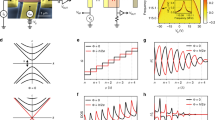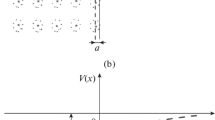Abstract
It is demonstrated in this work that the quantization of transverse motion of electrons in metal nanowires gives rise to transparency windows in the region of quasiclassical collisionless wave damping and makes the existence of excitations of a new type (quantum waves) possible in such systems.
Similar content being viewed by others
Avoid common mistakes on your manuscript.
The issue of the future application \({\text{of}}\) metal nanowires as elements of various nanodevices [1–5] requires extensive study aimed at predicting and observing fundamentally new physical effects in such systems. It is demonstrated below that a new type of waves (quantum waves) may be observed in quantum metal nanowires alongside the already known features of electromagnetic and other parameters of these nanowires. These features have been characterized rather well in literature.
The distinguishing feature of quantum metal nanowires is the dimensional quantization of transverse motion of electrons and retention of quasiclassical motion along a wire. The longitudinal velocity on the Fermi surface for degenerate Fermi electron system then assumes a discrete series of values, thus giving rise to “transparency windows” in the region of quasiclassical collisionless wave absorption and enabling the propagation of new (quantum) waves. Excitations of this kind in the electron systems of metals and semiconductors in a strong magnetic field were examined previously in [6–9].
Let us determine whether it is possible for quantum waves to emerge in metal nanowires and identify the key features of their propagation. To do that, we examine a simple model system: a long metal cylinder with a circular cross section, length \(L\), and radius \(R\) (R\( \ll \)L).
Wave functions \({{\psi }_{\nu }}({\mathbf{r}})\) (under the condition of vanishing on the lateral cylinder surface) and the spectrum of electron energies \({{\varepsilon }_{{\nu }}}\) in cylindrical coordinates \((r,\varphi ,z)\) with axis z directed along the cylinder axis are given by
Here, \({{I}_{l}}(\xi )\) is the Bessel function, \(I_{l}^{'}(\xi )\) = \({{d{{I}_{l}}(\xi )} \mathord{\left/ {\vphantom {{d{{I}_{l}}(\xi )} {d\xi }}} \right. \kern-0em} {d\xi }},\)\({{\alpha }_{{l,n}}}\) are positive zeros of function \({{I}_{l}}(\xi ),\) and \(p\) is the component of the electron momentum along the cylinder axis.
Owing to quantum effects, the electrons are split into groups corresponding to different energies of transverse motion \({{\varepsilon }_{{l,n}}}\). The longitudinal velocities of electrons \(\left( {{v} \equiv {{{v}}_{z}}} \right)\) of each group at \(T = 0\) fall within a finite interval \( - {{{v}}_{{l,n}}} < {v} < {{{v}}_{{l,n}}},\) where \({{{v}}_{{l,n}}}\) = \(\sqrt {{{2({{\varepsilon }_{{\text{F}}}} - {{\varepsilon }_{{l,n}}})} \mathord{\left/ {\vphantom {{2({{\varepsilon }_{{\text{F}}}} - {{\varepsilon }_{{l,n}}})} m}} \right. \kern-0em} m}} ,\)\({{\varepsilon }_{{\text{F}}}}\) is the Fermi energy of electrons. The associated regions of collisionless damping for waves propagating along a wire are summed so that “transparency windows” (regions without collisionless damping) form, thus enabling wave propagation.
In the quantum case, the excited nonequilibrium state of an electron system with eigen waves with frequency \(\omega \) is characterized by the following equation for nonequilibrium part \(\delta {{\rho }_{{{\nu \nu }'}}}\) of the density matrix:
Here, \({{f}_{{\nu }}} = f({{\varepsilon }_{{\nu }}})\) is the equilibrium Fermi distribution function and \({{W}_{{{\nu \nu }'}}}\) is the matrix perturbation energy element. Quantity \({{J}_{{{\nu \nu }'}}}[\delta \rho ],\) which is found at the right-hand side of the equation (“collision integral”), is related to electron scattering. It induces collision damping of propagating waves. To examine eigen waves, we consider the solutions with minimum contribution of damping by substituting this term with relaxation term –\({{\delta {{\rho }_{{{\nu \nu }'}}}} \mathord{\left/ {\vphantom {{\delta {{\rho }_{{{\nu \nu }'}}}} \tau }} \right. \kern-0em} \tau },\) where \(\tau \) is the relaxation time, in the (1/τ) → 0 limit.
In the case of longitudinal electromagnetic waves with l = 0 and wavelength \(2\pi {\text{/}}k\), \({{W}_{{{\nu \nu }'}}}\) corresponds to the interaction of electrons with the wave field potential \({{\varphi }_{{k{\omega }}}}{\text{:}}\)
Using (2) and (3) to determine nonequilibrium electron density nkω associated with the propagating perturbation
and substituting it into the equation for the scalar potential
one may easily find the equations for wave field potential \({{\varphi }_{{k{\omega }}}}\) or charge density \(e{{n}_{{k{\omega }}}}.\)
The dispersion relation for these waves (the condition of existence of a nontrivial solution of this problem) is then written as
In the considered case of propagation of waves along a wire, we have \({{n}_{{{\nu \nu }'}}}( - k)\) = \({{\delta }_{{nn{\kern 1pt} '}}}{{\delta }_{{p,p - \hbar k}}}\) and obtain the following from (6):
The second term within the curly brackets in this expression is associated with collisionless damping. It demonstrates that transparency windows without collisionless damping emerge on plane \((\omega ,k)\) in the region of quasiclassical collisionless wave absorption
These windows are defined by the following inequalities:
For the sake of convenience, we introduce index \(s = 1,2,3,...{{s}_{{\min }}},\) where \({{s}_{{\min }}}\) is the number of the boundary velocity of electrons with the highest transverse energy that may still be below the Fermi energy, enumerating the boundary velocities of electrons corresponding to different levels of transverse motion in descending order.
There are three types of transparency windows. Windows of the first type (regions \(\langle 1\rangle \) in Fig. 1) exist at relatively small \(k\), are shaped like petals on plane \(\left( {k,\omega } \right)\), and are bounded by parabolas \(\omega _{s}^{ - }(k)\) = \(k({{\nu }_{s}} - {{\hbar k} \mathord{\left/ {\vphantom {{\hbar k} {2m}}} \right. \kern-0em} {2m}})\) and \(\omega _{{s + 1}}^{ + }(k)\) = \(k({{\nu }_{{s + 1}}} + {{\hbar k} \mathord{\left/ {\vphantom {{\hbar k} {2m}}} \right. \kern-0em} {2m}}).\) Windows of the second type (regions \(\langle 2\rangle \) in Fig. 1) are found at relatively large \(k\), have a triangular shape on plane \(\left( {k,\omega } \right)\), and are bounded by sections of parabolas \(\omega _{s}^{ - }(k)\) = \(k({{\nu }_{s}} - {{\hbar k} \mathord{\left/ {\vphantom {{\hbar k} {2m}}} \right. \kern-0em} {2m}}),\)\(\omega _{{s + 1}}^{ + }(k)\) = \(k( - {{\nu }_{{s + 1}}} + {{\hbar k} \mathord{\left/ {\vphantom {{\hbar k} {2m}}} \right. \kern-0em} {2m}})\) and the line ω = 0. A parabolic transparency window (region \(\langle 3\rangle \) in Fig. 1) bounded by parabola \(\omega _{{{{s}_{{\min }}}}}^{ - }(k)\) = \(k({{{v}}_{{{{s}_{{\min }}}}}} - {{\hbar k} \mathord{\left/ {\vphantom {{\hbar k} {2m}}} \right. \kern-0em} {2m}})\) and the line ω = 0 lies between these two groups of windows.
The real part of Eq. (7) defines the dispersion laws for waves. The dispersion curves of quantum waves in the considered model lie within petaline transparency windows and correspond to the acoustic dispersion law in the long-wave limit. The existence of such waves is related physically to the presence of different groups of electrons on the Fermi surface. Therefore, the number of different branches of quantum waves is less by one than the number of occupied electron levels of transverse motion (i.e., levels with \({{\varepsilon }_{{l,n}}} < {{\varepsilon }_{{\text{F}}}}\)).
In particular, one branch of quantum waves exists in the model case of two occupied quantization levels with longitudinal electron velocities \({{\nu }_{1}}\) and \({{\nu }_{2}}\) on the Fermi surface. Their phase velocity \(u = \omega {\text{/}}k\) in the long-wave approximation is \(u \approx \sqrt {{{\nu }_{1}}{{\nu }_{2}}} .\)
If many quantization levels are occupied, a large number of quantum waves have the acoustic dispersion law in the long-wave approximation, and their phase velocities fall within the interval from the near-Fermi velocity to the minimum velocity on the order of \({\hbar \mathord{\left/ {\vphantom {\hbar {(mR)}}} \right. \kern-0em} {(mR)}}.\) The dispersion curve of the “slow” wave then lies approximately in the middle of the lower petaline transparency window. The dispersion curves of waves with near-Fermi velocities (“fast” waves) are close to the boundaries of transparency regions.
The quantization of the transverse energy of electrons is crucial for the existence of quantum waves. Therefore, they should also exist (with only slight modifications) in more realistic models. Finite temperatures and collisions, which smear the boundaries of transparency windows and reduce the possibility of existence of solutions of the dispersion relation, constrain the conditions under which quantum waves may be observed.
Quantum waves should manifest themselves, e.g., in the effects of absorption and reflection of waves by systems containing quantum metal wires.
Figure 1 illustrates the above reasoning. It shows the transparency regions and the dispersion curves of quantum waves in the model case of three occupied quantization levels.
REFERENCES
V. Ya. Demikhovskii and G. A. Vugalter, Physics of Quantum Low-Dimensional Structures (Logos, Moscow, 2000) [in Russian].
A. Kumar, As. Kumar, and P. K. Ahluwalia, “Ab initio study structural, electronic and dielectric properties of free standing ultrathin nanowires of noble metals,” Physica E 46, 259–269 (2012).
A. Pucci, F. Neubrech, D. Weber, S. Hong, T. Touru, and M. Lamy de la Capelle, “Surface enhanced infrared spectroscopy using gold nanoantennas,” Phys. Status Solidi B 247, 2071–2074 (2010).
E. A. Velichko and A. P. Nikolaenko, “Noble metal nanocylinders as diffusers of a plane electromagnetic wave,” Radiofiz. Elektron. 6, 62–69 (2015).
A. V. Korotun, “Fermi energy of a metal nanowire with elliptical cross section,” Phys. Solid State 56, 1245–1248 (2014).
A. L. McWhorter and W. G. May, “Acoustic plasma waves in semimetals,” IBM J. Res. Dev. 8, 285 (1964).
O. V. Konstantinov and V. I. Perel’, “Sound-type waves in an electron plasma of metals in a quantizing magnetic field,” Zh. Eksp. Teor. Fiz. 53, 2034–2040 (1968).
P. S. Zyryanov, V. I. Okulov, and V. P. Silin, “Quantum spin waves,” Pis’ma Zh. Eksp. Teor. Fiz. 8, 489–492 (1968).
V. I. Okulov, E. A. Pamyatnykh, and V. P. Silin, Electronic Quantum Waves in Magnetic Field (LENNARD, Moscow, 2020) [in Russian].
Funding
This study was supported by the Ministry of Science and Higher Education of the Russian Federation as part of the state task, project 5719.
Author information
Authors and Affiliations
Corresponding author
Additional information
Translated by D. Safin
Rights and permissions
About this article
Cite this article
Pamyatnykh, E.A. Electron Quantum Waves in Metal Nanowires. Phys. Metals Metallogr. 121, 405–407 (2020). https://doi.org/10.1134/S0031918X20050099
Received:
Revised:
Accepted:
Published:
Issue Date:
DOI: https://doi.org/10.1134/S0031918X20050099





